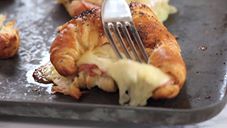Additional Notes:
• Making Mozzarella Without the Microwave: Instead of microwaving the curds to make mozzarella, warm a large pot of water to just below boiling (about 190°F). Pour the curds into a strainer and nestle the strainer into the pot so the curds are submerged in the hot water. Let the curds sit for about five minutes. Wearing rubber gloves, fold the curds under the water and check their internal temperature. If it has not reached 135°F, let the curds sit for another few minutes until it does. Once the curds have reached 135°, lift them from the water and stretch as directed.
• Milk for Mozzarella: Almost any milk can be used for making mozzarella: whole, 2%, skim, cow, goat, raw, organic, or pasteurized. Pasteurized milk is fine to use, but make sure that it is not ultra high temperature (UHT) pasteurized. The proteins in UHT milk have lost their ability to set into curds.
• Melting Homemade Mozzarella: I’ve found that homemade mozzarella doesn’t always melt as completely as store-bought mozzarella, especially if I’ve overworked the cheese and it has become very stiff. If you’re planning to make pizza or something else where melting is desired, use a whole-fat milk and make extra-sure not to overwork the cheese. It can also help to grate the cheese rather than slice it.
• Using Junket Rennet: Junket rennet is less concentrated than other kinds of rennet and isn’t ideal for making cheese. If this is all you have access to, try using 1-2 whole tablets to achieve a curd.
• Using Leftover Whey: Making mozzarella leaves you with almost 3 1/2 quarts of whey! You can use this whey in place of water in bread recipes and other baked goods, mix it into smoothies, or add it to soups.
[nextpagelink][/nextpagelink]







